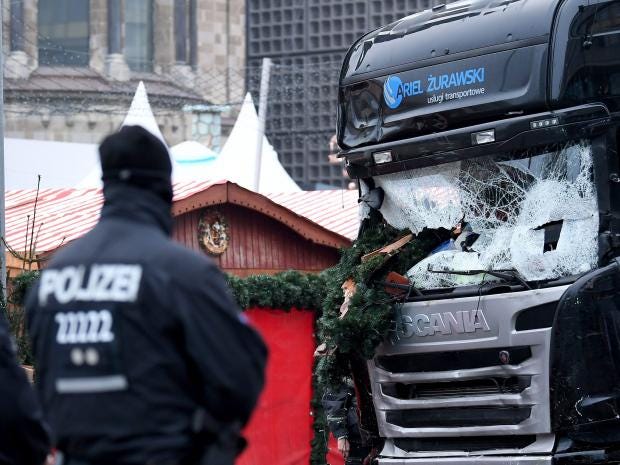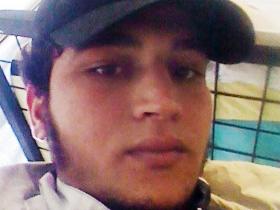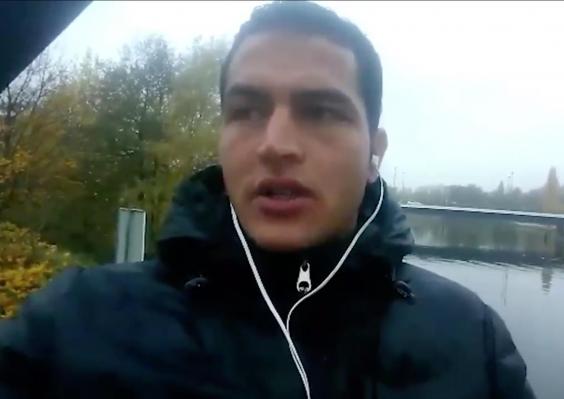Berlin attack: Lorry's automatic braking system stopped more deaths during the Christmas market assault
Investigators find system stopped Anis Amri continuing rampage that killed 12

An automatic braking system fitted to the lorry used in the Berlin attack may have prevented the deaths of many more victims, investigators have found.
Anis Amri, a Tunisian Isis supporter, is believed to have hijacked the vehicle from its Polish driver in the German capital before ploughing it into a busy Christmas market on 19 December.
Eleven people were killed and more than 50 others injured, being caught under the wheels or crushed by debris before the lorry came to a stop.
Investigators now believe the driver was only able to push a maximum of 260ft (80m) into the market because of the vehicle’s emergency braking system.
It kicked in after detecting obstacles and no response from the cab, bringing the lorry to a stop as quickly as possible given its forward momentum.
“The technology saved lives,” a Berlin local government official told the Süddeutsche Zeitung.
An older lorry used in the Nice attack was not equipped with the system, allowing Isis supporter Mohamed Lahouaiej-Bouhlel to kill 86 people and injure 400 more after driving into densely packed crowds celebrating Bastille Day.
His rampage lasted at least five minutes, while the Berlin attack happened in a matter of seconds after the lorry accelerated off a main road next to the Christmas market on Breitscheidplatz, according to witnesses.
There was initial speculation the lorry’s driver, Lukasz Urban, may have fought the hijacker in an attempt to prevent the attack but a post-mortem found he had been shot in the head at least two-and-a-half hours before and would have been unable to intervene.
The hijacker fled the scene and was later identified as Amri, whose wallet, identification, phone and fingerprints were found at the crime scene.
Minutes before the attack, he reportedly sent a message reading: “My brother, all is well, according to God's will. I am now in a car, pray for me my brother, pray for me.“
It was sent along with a selfie taken in the lorry’s cab to a contact, who remains unidentified after 40-year-old Tunisian man who arrested in Berlin was freed.
“Brother” is frequently used to address other Muslims, rather than exclusively relatives.
Amri was shot dead in a gun battle with Italian police in Milan on Friday after days on the run as the most wanted man in Europe.
The 24-year-old Tunisian man had a lengthy criminal history, including armed robbery in his home country and arson in Italy, where he was jailed for four years after arriving in Europe by boat in 2011.
Italian authorities attempted to deport Amri after he finished serving his prison sentence in 2015 but Tunisia refused to take him and he was released from a detention centre after the 60-day legal limit.
Amri’s brothers believe he was radicalised during his imprisonment, travelling onwards to Germany where he became part of an Islamist network including two hate preachers in Dortmund and Hildesheim who have since been jailed for supporting Isis.
Having flagged as a terror risk, he was put under surveillance over a separate attack plot in March but the investigation stopped in September after uncovering drug dealing and minor crime but failing to reveal evidence of extremism.
Security services rated Amri as a “five” on an eight-point danger scale and did not believe an attack was likely, Süddeutsche Zeitung reported, despite having evidence he volunteered to commit a suicide bombing and researched making explosives, and updating his file just five days before the Berlin attack.
Amri’s asylum application was denied in June but Germany was unable to deport him because Tunisia refused to accept the expulsion without documents proving his nationality.
Prosecutors in North Rhine-Westphalia also opened a fraud investigation after Amri was suspected using two of at least eight identities he employed in Germany to claim refugee benefits in two towns.
Detlef Nowotsch, a spokesman for prosecutors in Duisburg, told The Independent Amri applied for public funds in both Emmerich and Oberhausen in late 2015. But an investigation started in April was shelved in November because his whereabouts were unknown.
Authorities across Europe are attempting to piece Amri’s movements together through Germany, and then on his route via the Netherlands and France to Italy as he fled following the attack.
Italian police have searched three houses in and around Rome where he may have stayed after leaving a detention centre in Sicily in 2015.
Investigators are trying to establish whether Amri was attempting to reach another country when he was shot in Milan or seeking shelter with contacts in the city.
EU nations have vowed to work to increase security cooperation, while Angela Merkel ordered a sweeping security review to identify any necessary reforms in Germany.


No comments:
Post a Comment